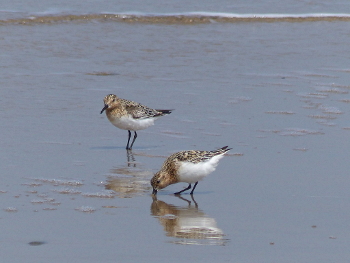Sanderling

Sanderling Information
Length: 7 - 8"
Habitat:
Breeding habitat: Rocky arctic tundra.
During migration and in winter: Sandy ocean beaches, mudflats, sandy edges of inland lakes and rivers.
Diet: Small crustaceans (especially, sand crabs), small mollusks, marine worms. On breeding grounds, insects and their larvae.
Additional Information
SanderlingHabitat, diet, feeding behavior, nesting, migration, and conservation status of this bird. Includes range map, photos, and songs and calls. (From Audubon Field Guide)
Sanderlings

By Ian Preston [CC 2.0]
Sanderling
Identification Tips
- Small shorebird
- Medium-length, thin, dark bill
- Dark legs
- Wide, white wing stripe
- Black line on rump extends onto tail
- Sexes similar
- Reddish head, back and breast with black spots
- Gray wings
- White belly
- Pale gray head and upperparts
- Faint, partial gray breast band
- White underparts
- Indistinct white supercilium and dark eyeline
(Credit: U. S. Geological Survey)
Range in New England
The Sanderling is locally common along the New England coast during fall migration.
This bird is also found during the winter along the coast of New England as far north as southern Maine.
Map from eBird
Sightings of the Sanderling throughout the year over past 10 years
(2009-2019)![]()
Christmas Bird Count Map
Historical CBC Map from USGS